By Bob Duncan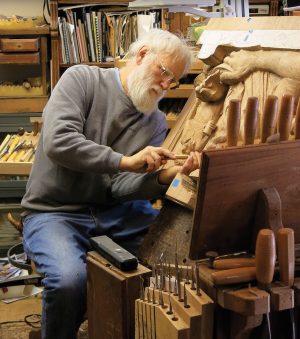
Fred Cogelow was destined to be a carver. “Everything just kept leading to it,” he said. His father was a woodworker who died when Fred was six, leaving behind a set of tools that Fred used to make his first carving: a face gouged into his mother’s breadboard. Fred later won his own set of cheap carving tools in a competition between newspaper delivery boys. When he graduated from high school, Fred attempted to carve a piece of an old fir moving beam. “I started carving with a dull carpenter’s chisel,” he said. “It was a miserable piece of wood. I worked on it for six hours with the chisel and a blow torch.”
Although his only formal art training was middle-school art classes, Fred kept carving. At the University of Chicago, he was inspired by the neo-Gothic architecture. “There were stone carvings outside and woodcarvings inside. I did a lot of gargoyles,” Fred said. “When I first started, I didn’t know how bad I was. If I had realized how pathetic I was, I would have quit out of pride. Fortunately, I was ignorant. With my degree in political science, I quickly burned out in the jobs I was qualified for. When I made myself otherwise unemployable, I realized I was either good at carving, or better than most, so I kept carving.”
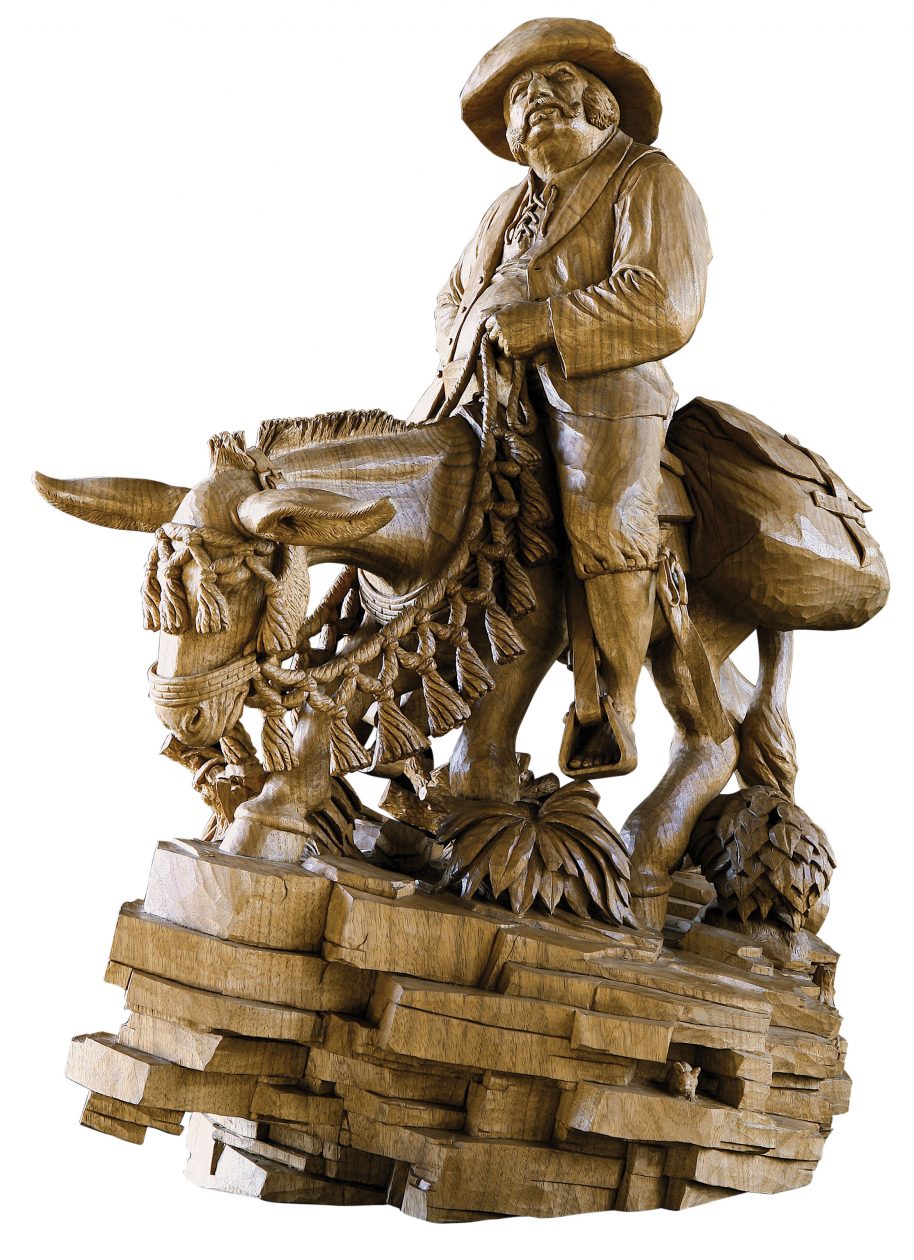 Fred often carves in a style he calls mezzo relief, which falls between and combines high and low relief. He enjoys warping the visible planes and perspective, compressing elements, and undercutting. Betty’s Spies, a piece that won Best of Show at the 2010 International Woodcarvers Congress (IWC) in Davenport, Iowa, is a good example of Fred’s style. Technically a relief because the back is not carved, the piece uses undercutting, perspective, and a judicious time-space warp to create a 3-D scene, even though the piece is only 3-3/4″ deep. Some of the people in the carving are realistic, while others are distorted or caricaturized. The background is carved in low relief.
Fred often carves in a style he calls mezzo relief, which falls between and combines high and low relief. He enjoys warping the visible planes and perspective, compressing elements, and undercutting. Betty’s Spies, a piece that won Best of Show at the 2010 International Woodcarvers Congress (IWC) in Davenport, Iowa, is a good example of Fred’s style. Technically a relief because the back is not carved, the piece uses undercutting, perspective, and a judicious time-space warp to create a 3-D scene, even though the piece is only 3-3/4″ deep. Some of the people in the carving are realistic, while others are distorted or caricaturized. The background is carved in low relief.
That said, Fred is no stranger to in-the-round carvings and has won several awards for his nearly life-sized busts. He averages 15 to 20 smaller pieces and four to five large, often life-sized, pieces each year. Carving most often in butternut, Fred occasionally draws on his political science background to create pieces of carved social commentary, such as Rest Easy Tonight, a piece Fred says represents the reaction the country had after the September 11 attacks.
Fred’s carving process incorporates drying time for the pieces, so he’ll often start working on a new piece while another one dries. He has plenty of ideas—in fact, he feels surrounded by them. “Any good artist is aware of his or her environment. The more you do, the more you should be able to perceive inspiration in the environment,” he said. “I have lots more ideas that I’ll never get to.” In fact, Fred has so many ideas that it’s sometimes difficult to return to a carving to finish it. “Demands pop up,” he said. “Other things come along.”
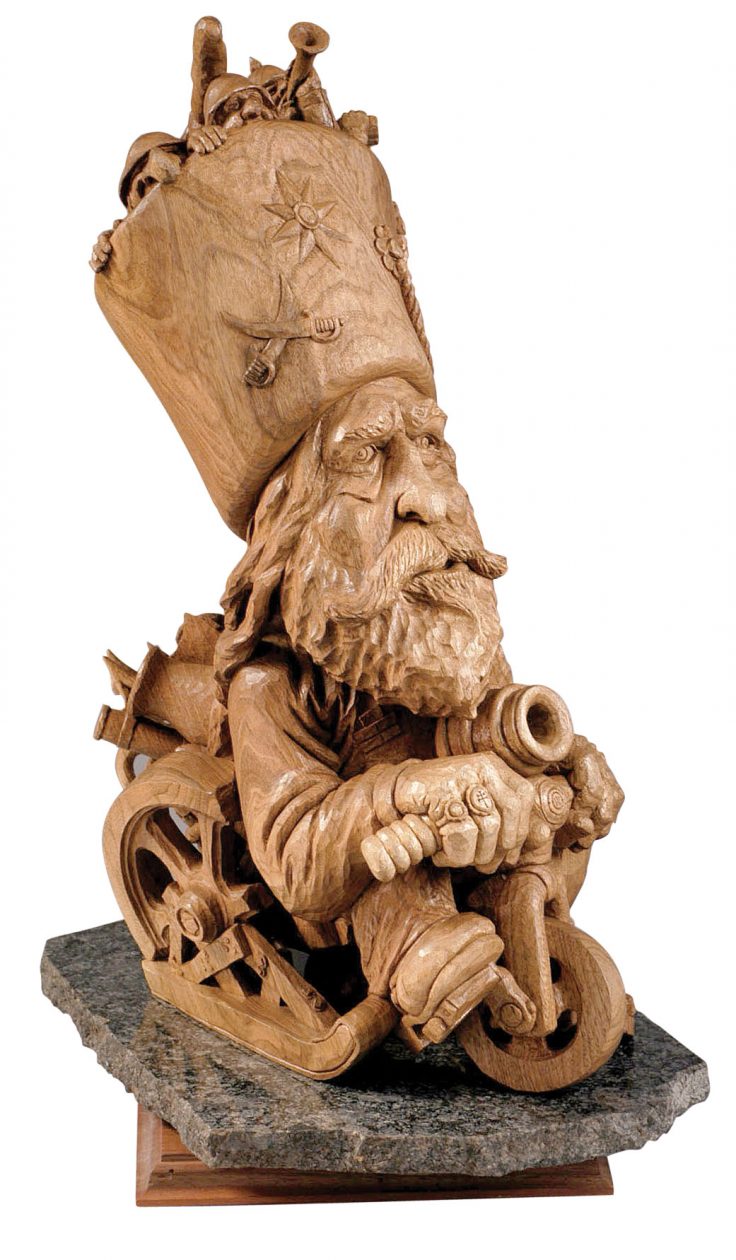 Among the “other things” last year was an exhibit called What Doughn’t Kill Ya… sponsored by a California real estate executive with ties to Fred’s hometown. He purchased one of Fred’s pieces and suggested that the artist put together a show of a half-dozen new mezzo-relief portraits. Fred completed the pieces and attended events in Utah and Colo.
Among the “other things” last year was an exhibit called What Doughn’t Kill Ya… sponsored by a California real estate executive with ties to Fred’s hometown. He purchased one of Fred’s pieces and suggested that the artist put together a show of a half-dozen new mezzo-relief portraits. Fred completed the pieces and attended events in Utah and Colo.
The artist also designs a line of tools for Henry Taylor Tools Ltd. in Sheffield, England. Based on tools that Fred created at home, the majority of them are side bent gouges and skews, which help carvers access tight or difficult areas. Fred developed the tools to help him undercut the deep areas, especially in mezzo-relief carvings. He considers the tools to be part of his legacy to the world of woodcarving. “I have some very good additions planned for the tool line, but I haven’t had time to get them into production. I need to do that while my eyeballs are still functional.”
Entering competitions also keeps Fred busy. He consistently wins top awards at the International Woodcarvers Congress and has won an impressive 12 Best of Show awards there since he entered his first piece in 1978.
Interestingly, Fred enters not for the competition itself, but as a form of marketing. “People don’t want to spend money on art,” he said. “They are buying a person’s reputation, not a person’s art.” He remembers making “a bit of a splash” after winning five Best of Group prizes in 1983. “I was off to the races,” he said. “The extra cash infusion [from prize money] was nice, but the recognition was what I wanted. It gave my name a bit of panache. Art generally is like the emperor’s new clothes—believing is seeing, rather than seeing is believing. People came to view my work with the expectation that it is exceptional. It helped to give me a strong local backing. That’s very important.”
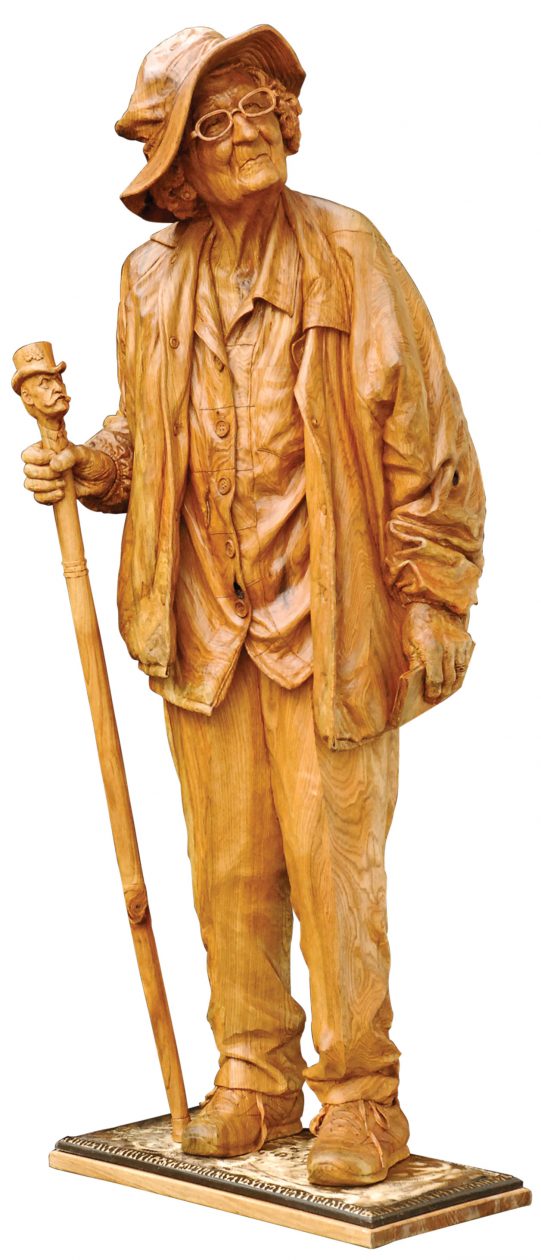 Early on, that local backing took the form of clients who bought a significant number of Fred’s larger pieces before they were even completed. Fred still sells many of his pieces directly to collectors, although he avoids commissions. Fred also works with the James Krom Natural Images gallery in Rochester, Minn. “The gallery neighbors the Mayo Clinic complex and draws the attention of an incredible number of individuals from around the nation and the world,” he said. “The gallery recently expanded, and the goal is to have a grand opening event this fall with myself as the featured artist.”
Early on, that local backing took the form of clients who bought a significant number of Fred’s larger pieces before they were even completed. Fred still sells many of his pieces directly to collectors, although he avoids commissions. Fred also works with the James Krom Natural Images gallery in Rochester, Minn. “The gallery neighbors the Mayo Clinic complex and draws the attention of an incredible number of individuals from around the nation and the world,” he said. “The gallery recently expanded, and the goal is to have a grand opening event this fall with myself as the featured artist.”
Despite his commercial and competition successes, Fred has mixed feelings about teaching his art. “I kind of enjoy the seminar experience,” he said, “but I don’t feel really fulfilled because I’m not sure I’m a good instructor. I always feel like if a person is ready to be a student or apprentice of mine, the person is ready to be out on his or her own, carving.
“Carving is outside learning about tools, finishes, and the wood itself,” Fred continued. “Carving is a logical process. Make your design, take the first logical steps, and then go to your next best guess.”
Larry Yudis, one of the organizers of the IWC, knows that while Fred may not enjoy teaching, he is still generous with his knowledge. “Fred walks around the Congress showroom making notes on various carvings,” Larry said. “He goes to the Congress secretary and asks for contact information for the carvers and sends them tips on what they can do to step up their carving to the next level.”
Larry has known Fred since the carver’s early days at Congress. “When our paths crossed in the early ‘80s, I knew I had run into someone very special,” Larry said. “There’s a tremendous difference between doing a realistic carving and carving the very soul of the subject being carved. Fred breathes life into his realistic carvings.” In addition, said Larry, “Fred has done caricature carvings, some reflecting his political views, as well as fantasy figures that go beyond the imagination. There really hasn’t been any subject matter that he’s tried that didn’t turn out very successfully.”
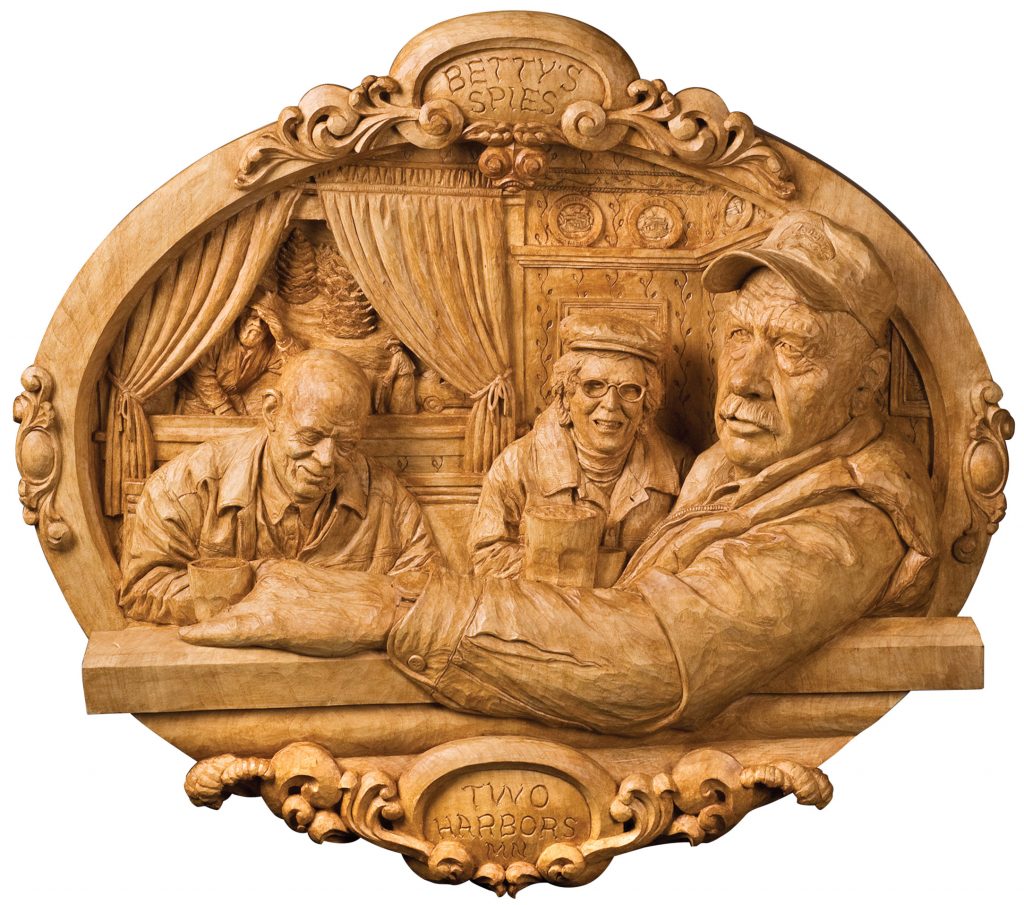 Alan Giagnocavo, the publisher of Woodcarving Illustrated, agrees. “Fred’s artistic eye, talented hands, and senses of humor and style elevate his pieces to what is more traditionally accepted as art. Fred has done a great deal to introduce woodcarving to the higher-end art world while staying consistent with his roots in woodcarving. And, this award-winning carver and artist still takes time to share his talents with other carvers. That is why Fred is the 2013 Woodcarving Illustrated Woodcarver of the Year.”
Alan Giagnocavo, the publisher of Woodcarving Illustrated, agrees. “Fred’s artistic eye, talented hands, and senses of humor and style elevate his pieces to what is more traditionally accepted as art. Fred has done a great deal to introduce woodcarving to the higher-end art world while staying consistent with his roots in woodcarving. And, this award-winning carver and artist still takes time to share his talents with other carvers. That is why Fred is the 2013 Woodcarving Illustrated Woodcarver of the Year.”
After carving professionally for 35 years, Fred shows no signs of stopping. “I’m grateful that I’m doing my best work ever right now,” he said “Visual artists have the potential to increase in quality as they age. I hope that might be true for me. My creative contribution to carving is to do the best work I can and increase the respect out there for this medium.”





